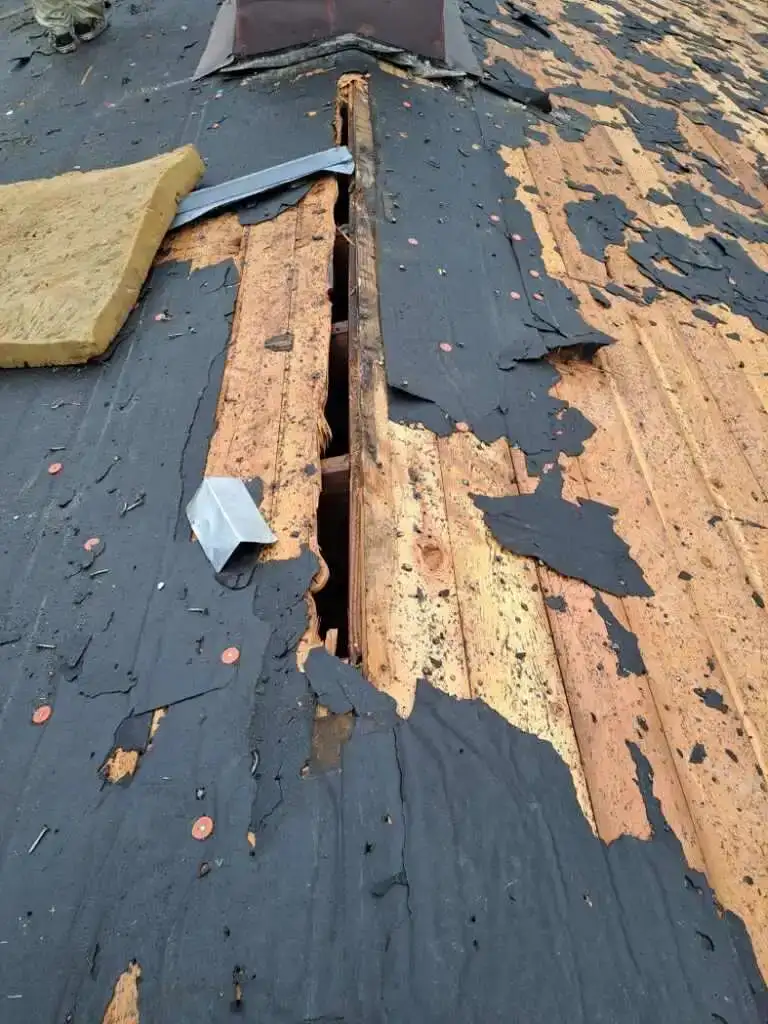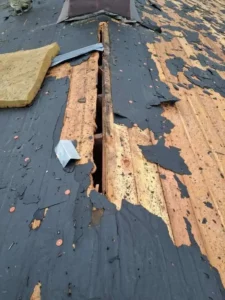To secure insurance coverage for roof replacement, document the damage thoroughly and review your policy details. Contact your insurance provider promptly.
Roof replacement can be a significant expense for homeowners. Understanding how to navigate insurance claims is crucial for financial relief. Start by thoroughly documenting any roof damage with photos and written descriptions. Review your insurance policy to understand coverage specifics and exclusions.
Promptly contact your insurance provider to report the damage and initiate the claims process. Accurate documentation and clear communication with your insurer can increase the likelihood of claim approval. Remember, each insurance policy is different, so knowing your specific coverage is key. This proactive approach ensures you’re well-prepared to secure the necessary funds for your roof replacement.
Table of Contents
ToggleIntroduction To Roof Replacement Insurance
Roof replacement can be costly, having the right insurance can help. Understanding roof replacement insurance is crucial. It ensures you get the best coverage.
Importance Of Coverage
Insurance coverage for roof replacement protects your finances. It helps you manage unexpected damages. Without insurance, you may face high costs.
Insurance can cover damages from storms, hail, and other events. This coverage ensures your home stays protected.
Common Challenges
Securing roof replacement insurance comes with challenges. Insurance companies may have strict requirements. Understanding these challenges helps you prepare.
- High deductible amounts
- Policy exclusions for certain types of damage
- Difficulty proving the cause of damage
Another challenge is documentation. You must keep detailed records. This includes photos and receipts. Proper documentation helps in claims.
Understanding your policy is key. Read it carefully. Know what is covered and what is not.
| Challenge | Solution |
| High Deductibles | Shop for better policies |
| Policy Exclusions | Understand your policy |
| Proving Damage | Keep detailed records |
Assessing Roof Damage
Ensuring your roof is in good condition is vital. Roof damage can lead to significant issues, including leaks and structural damage. Properly assessing roof damage helps in securing insurance coverage. This section guides you through the process.
Signs Of Roof Wear
Identifying signs of roof wear early can save you money. Look out for the following indicators:
- Missing shingles: Shingles protect your roof from the elements.
- Cracked or curled shingles: These can allow water to seep in.
- Granules in gutters: Shingles lose granules as they age.
- Water stains on ceilings: Indicates potential leaks.
- Moss or algae growth: This can trap moisture on your roof.
When To Call A Professional
Knowing when to call a professional can prevent further damage. Here are situations that warrant professional help:
- Visible sagging: This indicates structural issues.
- Severe storm damage: Storms can cause serious roof damage.
- Extensive water leaks: These can compromise your home’s integrity.
- Age of the roof: Roofs older than 20 years need regular inspections.
- Complex damage: Damage that you cannot assess properly.
Professionals have the tools and knowledge to assess your roof accurately. They can provide a detailed report for your insurance claim.
Understanding Your Policy
Securing insurance coverage for roof replacement begins with understanding your policy. This ensures you know what is covered and what is not. Read your policy carefully. Pay attention to specific terms and conditions.
Types Of Coverage
There are different types of coverage for roof replacement. It is important to know which type you have:
- Replacement Cost Coverage: This covers the cost of a new roof. It does not deduct for depreciation.
- Actual Cash Value Coverage: This covers the cost of the roof minus depreciation. The older your roof, the less you get.
- Extended Replacement Cost Coverage: This covers costs beyond the policy limit. It protects against sudden increases in material costs.
Policy Exclusions
Understanding policy exclusions is crucial. Not all damages are covered. Common exclusions include:
- Wear and Tear: Normal aging and deterioration are not covered.
- Poor Maintenance: If you neglect your roof, the insurance won’t cover the damage.
- Pre-existing Damage: Damage that existed before you got the policy is excluded.
- Certain Weather Events: Some policies exclude damage from specific weather events. Check if your policy covers hail or wind damage.
Always review your policy documents. Understanding these details helps you avoid surprises. If unsure, contact your insurance agent for clarification.
Documenting The Damage
Documenting the damage is a critical step in securing insurance coverage for roof replacement. Accurate records can significantly impact your claim’s success. This section covers the essential aspects of documenting the damage.
Taking Photos
Taking photos is the first step in documenting roof damage. Use a good quality camera to capture clear images. Focus on the affected areas.
- Take photos of damaged shingles.
- Include images of water stains inside the house.
- Photograph any visible structural damage.
Ensure photos are well-lit and in focus. Multiple angles provide a better perspective.
Writing A Detailed Report
Writing a detailed report is crucial. Start with a brief description of the damage. Mention the date and time of the incident.
- Describe the type of damage observed.
- Note any immediate repairs made to prevent further damage.
- Include details about weather conditions during the incident.
Use simple and clear language. The report should be easy to understand.
Provide as much detail as possible. Accurate information helps in processing your claim faster.
Filing An Insurance Claim
Filing an insurance claim for roof replacement can feel overwhelming. Follow these steps to ensure a smooth process. This section covers the step-by-step process and required documentation.
Step-by-step Process
- Review Your Policy: Check your insurance policy for coverage details.
- Document the Damage: Take photos of the roof damage.
- Contact Your Insurance Company: Call your insurance provider to report the damage.
- Schedule an Inspection: Arrange for an insurance adjuster to inspect the damage.
- Get Repair Estimates: Obtain quotes from licensed roofing contractors.
- Submit Your Claim: Provide all required documents to your insurer.
- Follow Up: Stay in touch with your insurer for claim status updates.
Required Documentation
Gathering the right documents is crucial for a successful claim. Below is a list of necessary documentation:
- Insurance Policy: Your insurance policy document.
- Photos: Clear pictures of the roof damage.
- Inspection Report: Report from the insurance adjuster.
- Repair Estimates: Quotes from roofing contractors.
- Claim Form: Completed insurance claim form.
- Proof of Loss: Detailed list of damages and costs.
Having these documents ready will speed up the claim process. Proper documentation ensures you get the coverage you need.
Working With Insurance Adjusters
Securing insurance coverage for roof replacement involves working with insurance adjusters. This process can be complex but essential for getting your claim approved. Below are key steps to help you navigate this process effectively.
Preparing For The Visit
Before the insurance adjuster arrives, gather all necessary documents. This includes the insurance policy, photos of the damage, and any repair estimates. Make sure to have a detailed list of the damage.
Here is a checklist to help you prepare:
- Insurance policy document
- Photos of roof damage
- Repair estimates from contractors
- List of damaged items
- Receipts for temporary repairs
Being well-prepared shows the adjuster you are serious. It also speeds up the claim process.
Negotiating Settlements
Once the adjuster reviews the damage, they will provide a settlement offer. Review this offer carefully. Make sure it covers all the damages listed.
If the offer seems low, don’t hesitate to negotiate. Use the estimates you gathered to back up your claims.
Here are some tips for effective negotiation:
- Stay calm and professional.
- Present your evidence clearly.
- Ask for a detailed explanation of the offer.
- Be prepared to counter-offer with your estimates.
- Document all communication with the adjuster.
Negotiation is key to getting a fair settlement. Always keep records of all discussions.
Remember, your goal is to ensure your roof replacement is fully covered. Proper preparation and negotiation can make a big difference.
Choosing A Roofing Contractor
Selecting the right roofing contractor is crucial for a successful roof replacement. The right contractor ensures quality work and helps secure your insurance coverage. This section will guide you on how to find and verify reputable roofing contractors.
Finding Reputable Contractors
Begin by researching contractors in your area. Ask friends and neighbors for recommendations. You can also check online reviews on trusted websites. Look for contractors with high ratings and positive feedback.
Create a list of potential contractors. Contact each one and ask questions about their services. A reputable contractor will provide clear answers and detailed information.
Checking Credentials
Verify the credentials of each contractor on your list. Check if they have the necessary licenses and insurance. Licensed contractors meet industry standards and regulations.
Request proof of insurance from each contractor. This protects you from liability in case of accidents. Make sure the contractor has both liability insurance and workers’ compensation.
It’s also essential to check for certifications from roofing manufacturers. Certified contractors often provide better warranties and use high-quality materials.
Use the table below to keep track of each contractor’s credentials:
| Contractor Name | License Number | Insurance Proof | Certifications |
| ABC Roofing | 12345 | Yes | GAF, CertainTeed |
| XYZ Roofing | 67890 | Yes | Owens Corning |
By following these steps, you can choose a reliable contractor. This ensures your roof replacement is completed to high standards.
Ensuring A Smooth Replacement Process
Securing insurance coverage for roof replacement can be challenging. To make the process smoother, it is essential to follow specific guidelines. Ensuring a smooth replacement process involves setting clear expectations and handling disputes efficiently.
Setting Expectations
Setting clear expectations is crucial for a smooth roof replacement. Here are some steps to follow:
- Review your insurance policy: Understand what your policy covers.
- Document the damage: Take photos and notes of the roof damage.
- Get multiple quotes: Compare quotes from different contractors.
- Communicate with your insurance adjuster: Keep in touch with your adjuster.
Handling Disputes
Disputes can arise during the roof replacement process. Here are some tips to handle them:
- Stay calm: Keep a cool head during disputes.
- Gather evidence: Collect all documents and photos.
- Seek a second opinion: Get an independent contractor to review the damage.
- Negotiate: Try to reach a fair agreement with your insurance company.
- Consider mediation: Use a mediator if disputes can’t be resolved.
By following these steps, you can ensure a smoother roof replacement process.
Post-replacement Considerations
Once your roof replacement is complete, it’s important to focus on post-replacement considerations. These steps ensure your new roof remains in excellent condition. Proper care and attention now can save you from future problems.
Final Inspection
After the roof replacement, a final inspection is crucial. This step confirms that the work meets all standards and requirements. The inspection should cover:
- Checking for any remaining debris or nails.
- Ensuring all shingles are securely fastened.
- Verifying that flashing and seals are intact.
- Confirming proper installation of gutters and downspouts.
Invite your insurance adjuster to join the final inspection. This ensures everything aligns with your policy requirements. Keep a record of the inspection for future reference.
Maintaining Your New Roof
Maintaining your new roof is essential for its longevity. Regular maintenance helps prevent minor issues from becoming major problems. Here are some tips:
- Regular Inspections: Inspect your roof at least twice a year. Look for signs of damage or wear.
- Clean Gutters: Keep gutters clean to prevent water buildup. This helps avoid leaks and water damage.
- Trim Trees: Trim trees near your roof to avoid damage from falling branches.
- Remove Debris: Clear any debris, like leaves and twigs, from your roof. This prevents mold and rot.
- Check Attic Ventilation: Ensure your attic is well-ventilated. Proper ventilation extends the life of your roof.
Following these maintenance tips ensures your new roof stays in top condition. A well-maintained roof provides better protection for your home.
Preventive Measures
Securing insurance coverage for a roof replacement can be a complex process. However, taking preventive measures can significantly ease this task. By regularly maintaining your roof, you not only extend its lifespan but also strengthen your case for insurance claims. Below are key preventive measures that can help you secure insurance coverage effectively.
Regular Inspections
Regular inspections are crucial for maintaining the health of your roof. Experts recommend inspecting your roof at least twice a year. During inspections, check for missing or damaged shingles. Also, look for signs of water damage or leaks. Professional inspections may be more thorough and can identify hidden issues. Keeping a record of these inspections can provide evidence to your insurance company.
Seasonal Maintenance Tips
Seasonal maintenance can prevent minor issues from becoming major problems. Here are some tips for different seasons:
| Season | Maintenance Tips |
| Spring |
|
| Summer |
|
| Fall |
|
| Winter |
|
By following these preventive measures, you can better maintain your roof and make a stronger case for insurance claims. Regular inspections and seasonal maintenance are key steps in this process.
Conclusion
Securing insurance coverage for roof replacement can be straightforward. Follow the outlined guidelines to ensure success. Document all damages, maintain clear communication with your insurer, and understand your policy details. These steps can help you navigate the process smoothly and protect your investment.
Stay informed and proactive to safeguard your home effectively.






